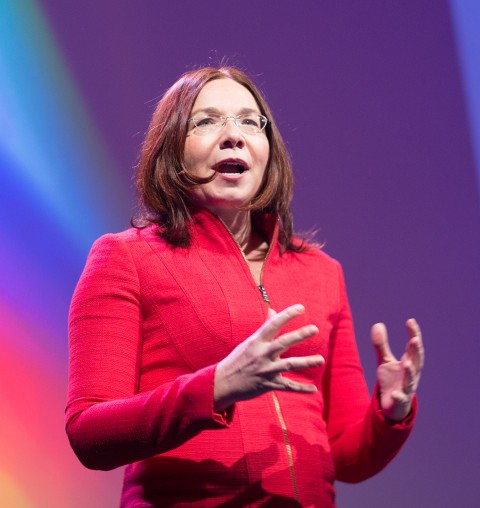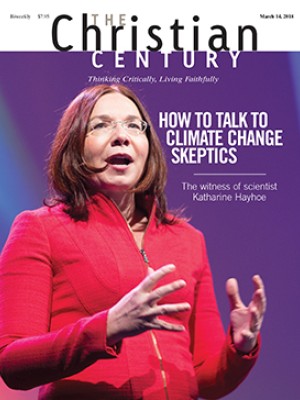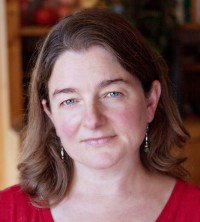A climate scientist talks—respectfully—to climate-change skeptics
“My message is that you don’t have to change who you are to care about this issue.”

Katharine Hayhoe is a professor and director of the Climate Science Center at Texas Tech University. She has led climate impact assessments for many cities and regions. Recognizing her ability to communicate the importance of climate change to skeptical audiences, the Yale Program on Climate Change Communication called her a “national treasure.” She also appears in the video series Global Weirding. She and her husband, Andrew Farley, a pastor, wrote A Climate for Change: Global Warming Facts for Faith-Based Decisions.
How did you begin trying to communicate to the skeptics about climate change?
It began inadvertently. I met my husband at the Inter-Varsity Christian Fellowship at the University of Illinois, when we were both in graduate school. We had been married six months or so before it dawned on us that we weren’t on the same page when it came to climate change.
Read our latest issue or browse back issues.
I come from Canada, where I took for granted that everyone agrees that climate is changing, humans are responsible for it, and we need to do something about it. He came from the American South, where many believe climate change is something liberal, atheist tree huggers have invented so that the government can rob people of their personal liberty and ruin the economy. I had never met anyone as intelligent and educated as my husband who didn’t think climate change was real. And he had never met anybody who believed the same things he did who thought it was.
Back then, 17 years ago, the issue was not as politicized as it is today. And we had another advantage: we not only loved each other, but we respected each other. I knew that he was a really smart person. He knew that not only did I share his faith, I was a practical person. I wasn’t somebody who wanted to ruin the economy to save the whales.
One conversation didn’t resolve our differences overnight. But over the course of months, through exploring the evidence and the implications together, he came to agree that climate change is real and human-caused and that the impacts are serious enough to warrant taking action.
How was that conversation like the others you’ve had since with people who deny climate change?
It was my first experience of starting from a place of mutual respect and shared values. And that, I realized, is the key to success: not just then but even more so today, when climate change has become one of the most politically polarized issues in the United States.
Today, the most accurate predictor of what people think about climate science—or even what the number on the thermometer means—is where they fall on the political spectrum. In a study done in 2017 in New Hampshire, during an unusually warm winter in the state, researchers asked, “Has this winter been unusually warm?” People’s perception of an event they had personally experienced differed based on their political affiliation. It doesn’t get more politically polarized than that!
How did you start speaking in churches?
By the time we moved to Texas about ten years ago, I realized that many people thought what I did as a climate scientist was one step removed from astrology—so I wasn’t sure what to expect. Within a couple of months of moving here, though, I was asked to speak to a women’s group about climate change. I did my best and fielded a lot of questions—some I could answer, some I couldn’t. The experience reminded me of the conversations I had had with my husband.
Soon, another invitation came to speak at a book club from a woman who had been in the first group. I adapted my presentation so it addressed many more of the questions people had asked in the first one—and got even more questions. Then another invitation came, to a church group. I adapted the presentation again and collected even more questions. And that’s what I’m still doing today, more than ten years later.
Whenever I’m invited to speak to conservative audiences—farmers, water managers, experts in the oil and gas industry, Christian colleges and churches—I try not only to anticipate but respect the questions they will have. My goal is to communicate that, yes, those are good questions that deserve good answers, so let’s talk!
What have these conversations taught you?
One of the most important things I’ve learned is that most people don’t really have a problem with the science or even the theology of climate change.
I know that there are lots of scientific sounding objections: “it’s just a natural cycle,” or “scientists don’t know enough yet,” or “those models are always wrong.” I hear these every day. And I also hear the religious objections: “if God is in control, then nothing bad can happen,” or “God gave us dominion over the earth, so we can do whatever we want,” or, “the earth is going to end anyway, so why does it matter?”
But if we talk about these concerns for more than a few minutes, the conversation quickly moves past the science and even the theology. People’s real objections are based on the fact that they believe the solutions to climate change conflict with their ideology and even identity. They’ve been told that climate change solutions will ruin the economy; that the issue is being pushed by godless liberal atheists, and Christians can’t go along with them; that the concern is a tool of the Democrats to expand big government and control people’s lives. And who wants any of that? I don’t.
Here’s the thing: those worries are not accurate. There are all kinds of solutions that energize local economies, build jobs, free people to develop their own energy sources, and—most importantly—fulfill our call to exercise responsible dominion over the planet and love others as Christ loved us. So my message is: we do not have to change who we are to care about this issue. Who we are is already the perfect person to care about this. We just need to connect the dots between the things that we already care about, how they are affected by a changing climate, and what we can do about it that is consistent with who we are.
What kind of connections do you make?
I’ve become increasingly convinced that nearly everyone already has the values they need to care about climate change. It’s just a matter of figuring out what values those are, then making the connection.
Many of those I speak with are Christians, so we can connect on our shared faith. In Genesis 1, humans are given dominion or stewardship or responsibility over every living thing on the planet. Whichever word we prefer, it’s impossible to interpret this as meaning pillage and plunder, given all we read of God’s joy and pleasure in creation throughout the rest of the Old Testament. It’s not just about nature, though; the Bible has a lot to say about caring for others, especially those less fortunate than us, those who are already poor and suffering. Climate change exacerbates the problems of hunger and poverty and lack of access to clean water, so for me, I care about climate change because it’s a humanitarian issue.
The Bible is by no means the only point of connection. We can connect over economics, how clean energy creates many more jobs than traditional fossil fuels, many of them local, and how it empowers us to develop our own energy rather than importing it. For those concerned about American exceptionalism and “making America great again,” it’s important to recognize that China is already well ahead of the United States when it comes to the new clean energy economy of the future. We all know what their air quality looks like; but what most people don’t realize is that they are changing, fast. They already have more wind and solar energy than any country in the world, and they are a global leader in manufacturing this technology. Continuing to shore up the coal industry when there are more jobs in solar energy than coal is like investing in horse farms and buggy manufacturing as the automobile is starting to be mass produced. It just isn’t competitive.
For those of us concerned about our health, we can connect the dots between the air pollution from fossil fuels and some 200,000 people in the United States who die every year as a direct result of this pollution. If we’re concerned about water, as many are in Texas, we know that the warmer it gets, the more water evaporates out of soils and reservoirs, exacerbating drought. Whoever we are, whatever we believe, whatever matters to us, these days there is more likely than not a connection to climate change: how it affects us and what we can do to make sure that we are reducing its impacts and prepared for those we can’t avoid.
Where do you take the conversation from there?
To solutions. All too often, we think solutions are punitive and unpleasant; that if we agree climate is changing and humans are responsible, then the only fix is to let the government control our thermostats, or control how many minutes we are allowed to shower, or even take away our trucks. But that’s not the case at all.
There are so many practical, beneficial solutions that we can all support and even implement in our day-to-day lives. New LED lightbulbs save us money—and don’t have to be changed nearly as often. Eating lower down the food chain reduces our carbon footprint—and benefits our health as well. Insulating our houses keeps energy costs down.
In addition to personal choices, we can do more. We can add our voice to organizations that reflect our personal values, from Young Evangelicals for Climate Action and Interfaith Power and Light to the free-market Energy Enterprise Institute or even the libertarian Niskanen Center. We can make our elected representatives aware of important programs like the U.S. Mayor’s Climate Protection Center and the bipartisan Climate Solutions Caucus in the U.S. Congress.
And perhaps most important, we can talk about solutions, like the fact that Fort Hood, the biggest army base in the United States, signed a new contract for solar and wind energy because it will save taxpayers over $150 million; or that there are at least six cities in the United States that are already using 100 percent renewable energy (including Georgetown, Texas); or that the cheapest prices for solar energy are in developing countries where people need it the most.
What specific actions do you recommend to church communities?
Church communities have so much potential: classes, sermons, book recommendations, guest speakers, even online communities like Climate Caretakers for people who want to “care for the climate through regular prayer and action that glorifies God and loves our neighbors.” It’s important to be a good steward of our finances; so a church might consider doing an energy audit to save money, which would also reduce the church’s carbon footprint and might free up funds to support for missions or invest in green energy options the church. As part of their witness, one congregation offered its roof to the community as a “solar panel garden,” because it’s often cheaper to put a lot of solar panels on one large structure like a church than dividing them up among homes. Churches are great places to help each other and build community by starting a composting program or a lightbulb initiative to replace senior citizens’ incandescent bulbs with the more efficient LED type, or by asking a local car dealership to park electric cars in the parking lot so that everybody can see what they look like or reaching out to elected officials to share their concerns.
How do you respond to eschatological concerns, like the notion that the world is going to end soon anyway?
My favorite Bible verse comes from 2 Timothy 1:7, which says that “God has not given us a spirit of fear.” This is a litmus test for us Christians. If something is inducing fear in us, it is not from God. What God has given us is a spirit of love, power, and a sound mind.
In the New Testament, the apostle Paul was writing letters to people who expected that Christ would return tomorrow or next week. He makes it very clear that although we don’t know the day and the hour, we are not to sit on our hands waiting for him to return, and we are certainly not to tremble in fear. We are to do good works, which includes loving and caring for others. And today, that includes addressing global issues like climate change that disproportionately impact the most vulnerable of us.
What are your goals for these conversations?
My goal is for people to feel empowered. So often, we feel as if climate change is this enormous global problem and nothing I can do about it will ever make a difference—so why bother? The truth is that the boulder is already rolling downhill, we just need more hands.
The Yale Program on Climate Change Communication surveyed thousands of people and categorized them into six different groups based on their relationship to action on climate change. They called the results the “Six Americas of Global Warming.” The categories are alarmed, concerned, cautious, disengaged, doubtful, and dismissive. And despite the fact that the loudest voices we usually hear from are the alarmed, on one end of the spectrum, and the dismissive, on the other, the majority of people in the United States are somewhere in the middle.
So my personal goal is to move people who are cautious, disengaged, or doubtful to concerned, recognizing that this does matter to me and there is something that I can do to help.
What is the most important action that you encourage people to take?
The number one thing that we can do is talk about climate change.
In addition to helping us understand where people are coming from, the Six Americas survey also asked how many times a year we hear someone else talk about climate change. It turns out that about 75 percent of people said less than one or two times a year.
Why should we expect someone to care about something that they never hear anyone talk about? Why would we expect someone to think that the problem can be fixed if we never hear anyone talk about solutions?
We may be scared to talk about climate change because we worry it will pick a fight, or we will have to argue about science, or it is just doom and gloom, such a downer. But as we’ve discussed above—and as I talk about in my Global Weirding videos—there are lots of positive ways we can connect this issue with things people already care about, to talk about why it matters to us and what we can do about it.
Tell us about your PBS series on Global Weirding.
Our Global Weirding series is now in its second season. Every other week, we release a short video that tackles a frequently asked question that has something to do with climate change. The prompt for the series came from a local PBS station, which thought it would be cool for a station in West Texas to do a series on the science, politics, and religion of climate change. The videos are purposely designed to be short and sharable and to give people interesting facts and perspectives they can use in conversation with others.
Questions we’ve talked about so far include: How do we know climate change is real? What do all of these crazy hurricanes have to do with global warming? What does the Bible say about climate change? Won’t plants and animals adapt? Aren’t you climate scientists just in this for the money? Are those airplane tracks we see in the sky a secret attempt by the military to cool the planet?
I haven’t heard that one.
Yes, that’s a big conspiracy theory in the darker halls of the Internet. Never mind that the logistics of secretly producing massive amounts of chemicals, shipping them to airports, and getting them on board commercial flights without the pilot’s knowledge or anyone else finding out is stunningly prohibitive; there are still thousands of people convinced that the normal condensation trails, or contrails, we see in the sky for minutes and even hours after planes have passed are actually a chemical experiment by the military to do . . . what? The answers never make sense—but hopefully our Global Weirding videos do!
Do you have time to do any science?
I have to make time, because doing science is what I love most. I work with big climate models, looking at how well they are able to reproduce the local climate patterns that bring heat waves and drought and storms. Then I translate that into information that people can use to make plans. For example, the city of Austin is using information that we generated in developing its long-term water plan, to make sure the city is prepared for a changing climate. Washington, D.C., is using our projections to plan for the future of infrastructure and public health. When it all comes down to it, we all want the same things: enough food to eat, clean air to breathe, clean water to use, and a safe place to live. Climate change threatens that, and that’s why it’s so important to prepare for its impacts.
A version of this article appears in the print edition under the title “How to talk to climate skeptics.”




